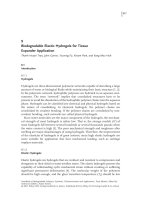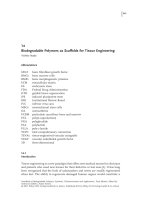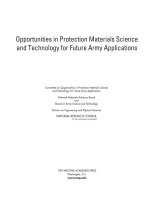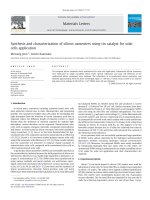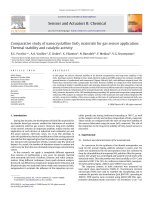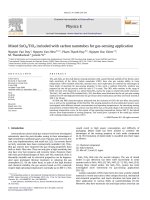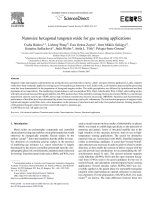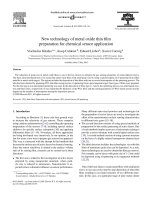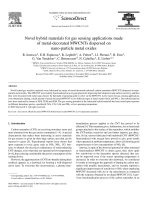Biodegradable Elastic Hydrogels for Tissue Expander Application
Bạn đang xem bản rút gọn của tài liệu. Xem và tải ngay bản đầy đủ của tài liệu tại đây (199.5 KB, 20 trang )
217
9
Biodegradable Elastic Hydrogels for Tissue
Expander Application
Thanh Huyen Tran, John Garner, Yourong Fu, Kinam Park, and Kang Moo Huh
9.1
Introduction
9.1.1
Hydrogels
Hydrogels are three-dimensional polymeric networks capable of absorbing a large
amount of water or biological fluids while maintaining their basic structure [1, 2].
In the polymeric network, hydrophilic polymers are hydrated in an aqueous environment. The term “network” implies that crosslinked structures have to be
present to avoid the dissolution of the hydrophilic polymer chains into the aqueous
phase. Hydrogels can be classified into chemical and physical hydrogels based on
the nature of crosslinking. In chemical hydrogels, the polymer chains are
crosslinked by covalent bonding. If the polymer chains are crosslinked by noncovalent bonding, such networks are called physical hydrogels.
Since water molecules are the major component of the hydrogels, the mechanical strength of most hydrogels is rather low. That is, the storage moduli (G′) of
most hydrogels fall between several hundreds or several thousands pascals when
the water content is high [3]. The poor mechanical strength and toughness after
swelling are major disadvantages of using hydrogels. Therefore, the improvement
of the elasticity of hydrogels is of great interest, since high elastic hydrogels are
more suitable for application that bear mechanical loading, such as cartilage
implant materials.
9.1.2
Elastic Hydrogels
Elastic hydrogels are hydrogels that are resilient and resistant to compression and
elongation in their dried or water-swollen states. The elastic hydrogels possess the
capability of withstanding cyclic mechanical strain without cracking or suffering
significant permanent deformation [4]. The molecular weight of the polymers
should be high enough, and the glass transition temperature (Tg) should be low
Handbook of Biodegradable Polymers: Synthesis, Characterization and Applications, First Edition. Edited by
Andreas Lendlein, Adam Sisson.
© 2011 Wiley-VCH Verlag GmbH & Co. KGaA. Published 2011 by Wiley-VCH Verlag GmbH & Co. KGaA.
218
9 Biodegradable Elastic Hydrogels for Tissue Expander Application
enough, to impart elastomeric behavior of the hydrogels [5]. Shape-memory hydrogels constitute a class of elastic hydrogels that can be elastically deformed and fixed
into a temporary shape, and have ability to recover the original, permanent shape
on exposure to an external stimulus such as heat or light [6].
For most biomedical applications, biodegradable elastic hydrogels are favored
over nondegradable hydrogels. This is because they can be removed or eliminated
by natural degradation from the applied sites in the body under relatively mild
conditions, thus eliminating the need for any surgical removal processes after the
system fulfills its goal. Biodegradable polymeric systems also provide flexibility in
the design of delivery systems for large molecular weight drugs, such as peptides
and proteins, which are not suitable for diffusion-controlled release through nondegradable polymeric systems [7]. In addition, the degradation can be utilized to
control the rate of drug release and the physicochemical properties of the hydrogel
systems, and thus to provide flexibility in the design of biomedical devices, such
as drug–biomaterials combination products. However, proper techniques for predicting hydrogel degradation rates are critical for successful application of these
degradable systems as they facilitate the design of implants with optimal degradation profiles that result in proper rates of drug release or tissue regeneration and
hence maximize therapeutic effects.
9.1.3
History of Elastic Hydrogels as Biomaterials
Earlier works in elastic hydrogels were mainly focused on development of shapememory hydrogels for fabrication of devices and implant stents. The first publication mentioning shape-memory effects in hydrogels was made by Osada et al. in
1995, who discovered a new phenomenon of a polymer hydrogel made by radical
copolymerization of acrylic acid and n-stearyl acrylate having elastic memory that
could be stretched to at least 1.5 times of its original length when the swollen gel
is heated above 50 °C [8, 9]. Since then, biodegradable shape-memory polymers
have been synthesized, including network polymers formed by crosslinking
oligo(ε-caprolactone) dimethylacrylate and N-butylacrylate [10], a multiblock copolymer of oligo(ε-caprolactone) and oligo(p-dioxanone)diol [11], and polyesters of
poly(propylene oxide) (PPO) with polylactide or glycolide [12]. Improvement of the
stiffness and recovery force of shape-memory polymers can be achieved by the
synthesis of shape-memory composites. Zheng et al. synthesized polylactide and
hydroxyapatite composites which demonstrated better shape-memory effect than
pure polylactide polymer [13].
Recently, with the increasing interest in engineering various tissues for the
treatment of many types of injuries and diseases, a wide variety of biodegradable
elastic hydrogels with desirable mechanical, degradation, and cytophilic properties
have been developed. Elastic superporous hydrogel hybrids exhibiting mechanical
resilience and a rubbery property in the fully water-swollen state have been
reported by Park et al. These hydrogel hybrids of acrylamide (AM) and alginate
could be stretched to about 2–3 times of their original lengths and could be loaded
9.1 Introduction
and unloaded cyclically at least 20 times. This property can potentially be exploited
in the development of fast- and high-swelling elastic hydrogels for a variety of
pharmaceutical, biomedical, and industrial applications [14, 15]. However, these
systems lack biodegradable properties for various biomedical applications. Wen
et al. developed biodegradable, biocompatible polyurethane-based elastic hydrogels
by changing chain extenders. The hydrogels were highly elastic in its swollen state
and comparable degradation and cytocompatible behaviors to polylactide. This
may find the applications in both soft- and hard-tissue regeneration [16, 17]. In
recent years, block copolymers of biodegradable polyesters such as poly(εcaprolactone) (PCL), polylactides (PLAs), poly(glycolic acid) (PGA), and polylactideco-glycolide (PLGA), and hydrophilic polyethylene glycol (PEG) have received
considerable attention as potential biomaterials because of their combined advantages of the biodegradability of the polyesters and the biocompatibility of PEG
[18–20]. The block copolymers also have some unique properties based on their
amphiphilic nature. The block composition and structural characteristics can be
utilized to modify various physicochemical properties such as biodegradation,
permeability, swelling, elasticity, and mechanical properties [21–23]. Typical
hydrogels are glassy and brittle in the dried state and it is difficult to change the
shape and size of the dried state. Huh et al. have developed biodegradable PEG/
PCL and PLGA–PEG–PLGA/PEG hydrogels showing flexible and elastic properties even in the dried state that they remain intact after repeated bending or
stretching to twice the original length [24].
Further, elastic hydrogels with self-healing capacity were synthesized by hydrophobic association through micellar copolymerization of AM and a small amount
of octyl phenol polyethoxy ether acrylate. These hydrogels showed high recovery
even after extensive stretching and self-healing after being cut into two parts which
can be used as shrinkable or thermal sensitive materials [25].
While covalently crosslinked hydrogels have the ability to control the elastic
behaviors, one limiting factor is the difficulty in guaranteeing removal of impurities, such as unreacted monomers, sol fractions, nonaqueous solvents, and initiators. Feldstein et al. demonstrated the formation of water-absorbing, elastic, and
adhesive hydrogels through hydrogen bonding of three pharmaceutical grade
components poly(N-vinylpyrrolidone) (PVP), PEG, and poly[(methacrylic acid)-co(ethyl acrylate)] [p(MAA-co-EA)] without introduction or formation of toxic byproducts. The hydrogels are malleable under various processing conditions such
as drawing, molding, and extrusion, suggesting a wide range of applications in
the biomedical and cosmetic fields [26].
9.1.4
Elasticity of Hydrogel for Tissue Application
Most natural tissues, such as heart, blood vessels, skeletal muscle, tendon, and so
forth, are very elastic and strong. If the biodegradable polymers are either too
stiff/brittle with low elongation, or very soft with relatively low strength, the
mechanical properties of these polymers are not compatible with natural tissues.
219
220
9 Biodegradable Elastic Hydrogels for Tissue Expander Application
The hydrogels are good candidates for tissue applications when their elastic moduli
are close to that of natural tissue components. For instance, articular cartilage
contains ∼70% water and bears loads up to 100 MPa, but most hydrogels, either
synthetic or natural, can be easily broken indicating that they are much weaker
than native cartilage tissue. The degradable elastic polyurethane hydrogels have
elastic moduli ranging from 16.8 ± 3.3 to 26.6 ± 3.9 MPa, which are very close to
the properties of native cartilage showing promise for soft- and hard-tissue regeneration [17].
For engineering of soft tissue, elastic hydrogel scaffolds are desirable since they
are amenable to mechanical conditioning regimens that might be desirable during
tissue development. Elasticity values of most of the single component hydrogels
were lower than 10 kPa, while higher percentage of multicomponent hydrogels
exhibited high elastic mechanical property up to 100 kPa [3]. The compressive
modulus of hard tissue such as articular cartilage is in the range of 0.53–1.82 MPa
[27]. In order to promote cartilage regeneration, a hydrogel scaffold must be able
to exhibit mechanical integrity in the face of loading from the body, while at the
same time guide appropriate cartilaginous tissue growth. A biodegradable hydrogel scaffold with elastic properties could be useful for application in cartilage
treatment.
9.2
Synthesis of Elastic Hydrogels
9.2.1
Chemical Elastic Hydrogels
Chemical hydrogels are those that have covalently crosslinked networks. Thus,
chemical hydrogels will not dissolve in water or other organic solvents unless
covalent crosslinks are cleaved. There are generally two different methods to
prepare chemical elastic hydrogels. Chemical elastic hydrogels can be prepared by
polymerization of water-soluble monomers in the presence of bi- or multifunctional crosslinking agents. Chemical hydrogels can also be prepared by crosslinking water-soluble polymers using chemical reactions that involve functional
groups of the polymer. Due to the high strength of the covalent linkages, the
three-dimensional networks of hydrogels are permanent and the formation of
crosslinks is usually irreversible.
9.2.1.1 Polymerization of Water-Soluble Monomers in the Presence
of Crosslinking Agents
Polymerization of water-soluble monomers in the presence of crosslinking
agents results in the formation of chemical hydrogels. Typical water-soluble monomers for the preparation of chemical elastic hydrogels include acrylic acid, AM,
hydroxyethyl methacrylate, and so on. The crosslinking agents for the synthesis
of elastic hydrogels are not only low-molecular-weight agents such as N,N′methylenebisacrylamide but also inorganic agents such as hectorite clay.
9.2 Synthesis of Elastic Hydrogels
Figure 9.1 Structure of nanocomposite hydrogel using Clay-S by in situ polymerization.
For example, a novel highly resilient nanocomposite hydrogel with ultrahigh elongation was prepared by polymerization of monomer (AM or Nisopropylacrylamide (NIPAAm)) in the presence of the inorganic hectorite clay as
a crosslinker (Clay-S), initiator (potassium persulfate), and accelerator (tetramethyldiamine) [28]. As shown in Figure 9.1, Clay-S forms a stable uniform dispersion
in a solution that contains monomer and other reagents. Polymerization is initiated on the surfaces of the clay, and polymer chains are attached to the clay surface
to form clay-brush particles, and finally, the aqueous dispersion is converted into
a nanocomposite hydrogel of the uniform polymer network of Clay-S and AM,
which can distribute stress evenly on each chain. The hydrogel could be elongated
to 10 times of its original length and recovered to initial state.
In another approach, a hybrid of chemical and physical hydrogels was prepared
from polyacrylamide and sodium alginate [14]. The copolymerization of AM
monomer and N,N′-methylenebisacrylamide as a crosslinker and other necessary
ingredients formed superporous polyacrylamide hydrogels. The crosslinking
density of the hydrogel was increased by the physical crosslinking of sodium
alginate with Ca2+. The mechanical properties of the superporous hydrogels can
be significantly increased through this interpenetrating network formation.
9.2.1.2 Crosslinking of Water-Soluble Polymers
Crosslinking of water-soluble polymers by the addition of bifunctional or multifunctional reagents results in chemical elastic hydrogels. Macromers are macromolecular monomers or polymers that contain two or more vinyl groups, acrylates
and methacrylates being the most common. The crosslinking reactions can be
catalyzed chemically, thermally, or photolytically. Photopolymerization is an
increasingly common way to drive the crosslinking reaction.
Degradable polyurethane-based light-curable elastic hydrogels were synthesized
from polycaprolactone diol, PEG as soft segment, lysine diisocyanate as hard
221
222
9 Biodegradable Elastic Hydrogels for Tissue Expander Application
segment, and 2-hydroxylethyl methacrylate as chain terminator through UV-lightinitiated polymerization. The hydrogels were formed through the crosslinking of
methacrylate groups in 2-hydroxylethyl methacrylate via UV light. The PCL:PEG
ratios in soft segments were responsible in determining elasticity as well as the
strength of the hydrogels [17].
The formation of degradable hydrogels by crosslinking macrodimethacrylates
was also reported by Choi et al. [12]. Triblock copolymers of PLA–PPO–PLA containing polylactic acid (PLA) blocks and acrylate end groups of PPO were used to
create photopolymerizable hydrogels showing shape-memory property.
Recently, the formation of elastic hydrogels from block copolymer of PEG and
biodegradable polyesters has been extensively investigated. PEG is a hydrophilic
polymer and its glass transition temperature is very low due to the flexible chain
structure. When PEG was used as a building block for preparing hydrogels with
other biodegradable polyesters such as PGA, PLA, and PCL, the hydrogels can
show flexible and/or elastic properties [4, 24, 27]. PEG has two hydroxyl groups at
both ends of the polymer that can be modified with a vinyl group to form a divinyl
macromer. PEG acrylates are the major type of macromers for the preparation of
PEG-based elastic hydrogels. For example, chemically crosslinked biodegradable
elastic PEG/PCL or PLGA–PEG–PLGA/PEG hydrogels were prepared via radical
crosslinking reaction of PEG-diacrylate with PCL-diacrylate or PLGA-PEG-PLGAdiacrylate in the presence of a radical initiator 2,2-azobisisobutyronitrile in a drying
oven at 65 °C for 12 h [24]. Scheme 9.1 illustrates the synthetic method of PLGAPEG-PLGA diacrylate using for crosslinking reaction with PEG-diacrylate under
thermal catalyst.
9.2.2
Physical Elastic Hydrogels
Physical gels are the continuous, disordered, three-dimensional networks formed
by associative forces capable of forming noncovalent crosslinks [29]. Noncovalently
crosslinked hydrogels are formed when primary polymer chains contain chemical
moieties capable of electrostatic, hydrogen bonding, ion dipole, or hydrophobic
interaction [26]. Physical crosslinking of polymer chains can also be achieved using
a variety of environment triggers (pH, temperature, and ionic strength). In physical elastic hydrogels, association of certain linear segments of long polymer molecules forms extended “junction zones.” The junction zones are expected to
maintain ordered structure. Although noncovalent association are reversible and
weaker than chemical crosslinking, they allow solvent casting and thermal processing, and the resulting polymers often show elastic or viscoelastic properties [30].
9.2.2.1 Formation of Physical Elastic Hydrogels via Hydrogen Bonding
Examples of elastic and adhesive hydrogels via the formation of hydrogen bonding
are triple blends of PVP, PEG, and p(MAA-co-EA). Ternary polymer blends were
dissolved in ethanol under vigorous stirring, and then casted into film. The PVP/
PEG/p(MAA-co-EA) hydrogel was formed via the stable three-dimensional
9.2 Synthesis of Elastic Hydrogels
HO
H
O x
PEG
O
H3C
Sn(Oct)2, 140°, 5 h
O
O
O
O
CH3
O
lactic acid
O
glycolic acid
O
O
HO'
O
(
O
)(
O
CH3
)(
O
O )(
)(
H
)
O
O
O
PLGA-PEG-PLGA
triethylamine
acryloyl chloride
O
80°, 3 h
O
O
O
(
)(
)(
O
Om
CH3
x
O
O
)(
O
n
O
)(
m
CH3
O
)
x
O
PLGA-PEG-PLGA diacrylate
Scheme 9.1
Synthetic methods of PLGA–PEG–PLGA diacrylate.
hydrogen-bonded network in which p(MAA-co-EA) contains H-bond donor groups,
PVP contains H-bond acceptors, and PEG contains both. The hydrogel films are
malleable and retain their integrity upon hydration – a feature characteristic of
covalently crosslinked hydrogels. The polymer blend films remained intact at
pH 5.6 but underwent dissolution at pH 7.4 due to loss of hydrogen bonding and
development of charge repulsion [26].
Hydrogen-bonding interaction can also be used to produce hydrogels by freezethawing. A novel double-network elastic hydrogel fabricated with PVP and PEG
was prepared through a simple freezing and thawing method. PVA/PEG hydrogel
structure was formed by a PVA-rich first network and a PEG-rich second component, in which hydrogen bonding existed. The two polymers were dissolved in
ultrapure water and exposed to repeated cycles of freezing at −20 °C for 8 h and
thawing at room temperature for 4 h. Figure 9.2 illustrates the structural formation
of elastic PVA/PEG double-network hydrogels. The condensed PVA-rich phase
forms microcrystals first, which bridge with one another to form a rigid and inhomogenous net backbone to support the shape of the hydrogels, and the dilute
PEG-rich phase partially crystallizes among the cavities of voids of the backbone.
PEG clusters in the cavities of PVA networks absorb the crack energy and relax
223
224
9 Biodegradable Elastic Hydrogels for Tissue Expander Application
Figure 9.2 Schematic representation of the structural model of PVA/PEG double-network
hydrogel.
the local stress either by various dissipations or by large deformation of the PEG
chains. The crystalline regions of PVA essentially serve as physical crosslinks to
redistribute external stresses [31].
9.2.2.2 Formation of Physical Elastic Hydrogels via Hydrophobic Interaction
Polymers with hydrophobic domains can crosslink in aqueous environment via
reverse thermal gelation. Temperature increase promotes hydrophobic interactions resulting in the association of hydrophobic polymer chains. The physical
association of hydrophobic domains holds swollen soft domains together and
makes the polymers stable in water [32]. The common hydrophobic blocks which
can undergo reverse thermal gelation at or near physiological temperature are
PPO, PLGA, poly(N-isopropylacrylamide), PCL, and poly(urethane) [33].
For example, multiblock copolymers of polyethylene oxide and PCL or PLA
were synthesized for the preparation of polymer films by solvent casting method.
The multiblock copolymers formed thermoplastic hydrogels via hydrophobic
interaction. The block copolymer films were rubbery in both dried and swollen
states. The interesting property of these multiblock copolymers was that the swelling increased by increasing temperature and increased further, rather than
decreasing, when the temperature was lowered to the initial temperature [30].
Other types of amphiphilic block copolymers of PCL with PLA and PGA were
also synthesized to prepare elastic PCL/PLA and PCL/PGA physical hydrogels
[4, 27].
9.3 Physical Properties of Elastic Hydrogels
Figure 9.3 Schematic illustration of the hydrophobic association of hydrogels, which consists
of associated micelles and flexible polymer chains connected by neighboring associated
micelles.
In another example, a new type of physically crosslinked hydrogel via hydrophobic interaction was prepared. An elastic hydrogel with self-healing property was
synthesized through micellar copolymerization of AM and a small amount of
octylphenol polyethoxyether acrylate in an aqueous solution containing sodium
dodecyl sulfate at 50 °C. The hydrophobically modified polyacrylamide was synthesized by the copolymerization of AM and octylphenol polyethoxyether acrylate.
After polymerization, hydrophobic association of SDS and hydrophobic microblocks of hydrophobically modified polyacrylamide leads to the formation of associated micelles. These micelles act as crosslinking points, so three-dimensional
polymer networks were constructed as shown in Figure 9.3 [25]. Because of the
large distance between the associated micelles, all polymer chains between the
crosslinking points in the hydrogels were sufficiently long and flexible.
9.3
Physical Properties of Elastic Hydrogels
Some of the most important properties of elastic hydrogels are: the gel mechanical
properties, to withstand the physiological strains in vivo or mechanical conditioning in vitro; gel swelling properties to maintain cell viability; and the degradation
profiles to match tissue regeneration.
9.3.1
Mechanical Property
Mechanical properties of elastic hydrogels are evaluated by the measurement of
elasticity and stress relaxation. Elasticity is estimated from the tensile strength,
225
9 Biodegradable Elastic Hydrogels for Tissue Expander Application
elongation at break, and recovery after stretching. The mechanical tests are performed with hydrogel samples in a fixed cross-sectional area by pulling with a
controlled, gradually increasing force until the sample changes shape or breaks.
When a constant strain is applied to a rubber material, the force necessary to
maintain that strain is not constant but decreases with time, this behavior is called
“stress relaxation.” Stress relaxation of hydrogels was determined by the following
equation:
(maximum stress at a constant strain/stress at the constantt strain after
holding for a determined time) × 100.
The tensile strength of elastic hydrogels is dependent on the crosslinking density
and the flexibility of the water-soluble monomer or macromers in water. The
elastic hydrogels exhibit rubberlike profiles in the stress–strain curves with very
high elongation at break as shown in Figure 9.4. The recovery after stretching is
usually more than 90% when applied up to the tensile strain at break.
Stress relaxation describes how polymers relieve stress under constant strain.
In viscoelastic materials, stress relaxation occurs due to polymer chain rearrangement allowing permanent deformation of the materials. By this method, low
values for stress relaxation indicate that polymer chain rearrangement is occurring. Example of stress relaxation of elastic hydrogel is given in Figure 9.5. The
stress relaxation of all samples was more than 90%, indicating that polymer chain
rearrangement is occurring only minimally. Since these hydrogels are highly
crosslinked, there is little freedom for rearrangement and, as such, these materials
do not deform under stress.
Stress-strain curve
9
8
7
Stress (kPa)
226
6
5
4
3
2
1
0
0
200
400
600
800
Strain (%)
1000
1200
Figure 9.4 Stress–strain curve of elastic film prepared from poly(l-lactide-co-ε-caprolactone).
9.3 Physical Properties of Elastic Hydrogels
Stress relaxation at 60 s (%)
120
100
80
60
40
20
0
#1
#2
#3
#4
Sample
#5
#6
#7
Figure 9.5 Stress relaxation of PLGA–PEG–PLGA/PEG elastic hydrogels.
9.3.2
Swelling Property
The swelling property of hydrogels is usually characterized by measuring their
capacity to absorb water or aqueous solutions. The swelling ratio (Rs), which is the
most commonly used parameter to express the swelling capacity of hydrogels, is
defined as follows:
Rs = (Ws − Wd )/Wd
(9.1)
where Ws and Wd are the weights of swollen and dried hydrogels, respectively.
It is well known that the swelling ratio of hydrogels not only depends on the
hydrophilic ability of the functional groups but also on the network space of the
hydrogels. Generally, the hydrogel with higher network space presents higher
water content. Ionization often provokes swelling due to electrostatic/osmotic
repulsion of polyelectrolyte chains.
Swelling pressure is the pressure exerted on the swelling hydrogels due to the
osmotic effect or the degradation of the crosslinking structure. The swelling pressure (πsw) of a neutral polymer gel is determined by two opposing effects: the
osmotic pressure (πosm) that expands the network and the elastic pressure (πel) that
acts against expansion [34]:
π sw = π osm + π el
(9.2)
where πel = −G′, G′ being the elastic (shear) modulus of the hydrogel.
Swelling pressure is usually measured during the degradation of hydrogels at
the accelerated condition close to physiological condition, for example, in the
227
9 Biodegradable Elastic Hydrogels for Tissue Expander Application
isotonic solution of 0.154 M HCl. Up to present, no relationship between swelling
pressure and swelling ratio of neutral hydrogels has been reported. However, it is
known that swelling pressure gradually increases in the course of the degradation
process and depends on the mechanism of the degradation. For example, the
dextran gels are degraded at their backbone, the swelling pressure increases rather
continuously; in the case where they are degraded at the crosslinks, it increases
more discontinuously and a sudden increase occurs when the gels are completely
degraded [35]. Similarly, an increase in swelling ratio of hydrogels occurs in the
first period of the hydrogel degradation due to the decrease of the crosslinking
density of hydrogels. As the degradation proceeded further, the swelling ratio
decreases to zero since the network structure of hydrogels broke down. The swelling ratio and the swelling pressure of a hydrogel depend on internal and external
factors. The internal factors are the polymer network of the hydrogel. The swelling
ratio and the swelling pressure of a gel are determined by: (i) osmotic pressure,
(ii) the rubber elasticity, and (iii) polymer–polymer interaction of the polymer
network [36]. The external factors are parameters of the solution like the concentration and electric charge of the solute molecules or ions.
Swelling pressure of hydrogels is also measured under the osmotic condition
to determine the ability of the hydrogels as a tissue expander. Osmosis is the main
driving force of the volume expansion of an anhydrous gel body in the solutions
of living tissue [36]. Mechanical work can be done when hydrogels transform
osmosis into real pressure. In this case, the role of a gel to act as a pressuregenerating device is based on the balancing of the osmotic pressure and the rubber
elasticity. If the swelling pressure can overcome the resistance of the adjacent
tissue, it is sufficient to dilate the surrounding tissue at the expected rate [37].
Previous research has established that a pressure close to 100 mmHg is ideal for
tissue expansion [38]. As an example, the swelling pressure of PLGA–PEG–PLGA/
PEG elastic hydrogels is given in Figure 9.6. All these hydrogels can create swelling
pressure more than 400 mmHg which is sufficient for tissue expansion.
1000
800
mmHg
228
600
400
200
0
#1
#2
#3
#4
#5
Sample
#6
#7
Figure 9.6 Swelling pressure of PLGA–PEG–PLGA/PEG elastic hydrogels.
9.4 Applications of Elastic Hydrogels
9.3.3
Degradation of Biodegradable Elastic Hydrogels
Degradation of polymer hydrogel networks can occur by different mechanisms:
(i) by hydrolysis of side chains or pendant groups, (ii) by cleavage of the polymeric
backbone, and (iii) by cleavage of labile groups in the crosslinks [35]. Biodegradation of hydrogels occurs by either simple hydrolysis or by enzyme-catalyzed hydrolysis. In vitro degradation rate of biodegradable elastic hydrogels was generally
evaluated by measuring the weight loss and swelling ratio of the samples in phosphate buffered saline solution at multiple time points at 37 °C with gentle shaking
to mimic the in vivo environment. The degradation of the gel is a function of the
crosslink density, as well as the hydrolytic susceptibility of chemical bonds. Hydrogels made from lower molecular weight precursors are more tightly crosslinked
and thus degrade more slowly than hydrogels made from higher molecular weight
precursors. Degradation of the biodegradable hydrogel network led to decreased
crosslinking density, which increased the hydrogel swelling ratio. Figure 9.7 gives
an example of in vitro degradation properties of PLGA-PEG-PLGA/PEG elastic
hydrogels at different ratios of lactic acid/glycolic acid. The hydrogels showed
various lag times before swelling depending on the chemical composition of the
triblocks and the PLGA-PEG-PLGA/PEG block composition ratio. The hydrogels
with higher content of PEG block showed lower degradation rates due to higher
crosslinking density of low-molecular-weight PEG. As the degradation proceeded
further, the network structure finally broke down so that the hydrogel mass was
disintegrated into soluble degradation products.
9.4
Applications of Elastic Hydrogels
9.4.1
Tissue Engineering Application
Due to the high mechanical property, most biodegradable elastic hydrogels are
attractive for development or regeneration of both soft- and hard tissues. For
example, PEG/PCL and poly(lactide-co-caprolactone) (PLCL) elastic hydrogels have
been investigated for use as scaffolds for cartilage regeneration [27, 39]. Chondrocyte cells were found to be dispersed evenly through the scaffold material without
any further prewetting treatment, and remained viable after 3 weeks of culture.
The PEG/PCL scaffold-seeded chondrocytes enhanced the gene expression of
chondrogenic differentiation in a time-dependent manner. The formation of neocartilage was increased over 4 weeks after implantation in nude mice [39]. The
elastic PLCL scaffolds maintained their mechanical integrity after implantation
and guided cartilaginous tissue growth in vivo [27].
The application of cyclic mechanical strain during the smooth muscle tissueengineering process has been found to show increased elastin and collagen
229
9 Biodegradable Elastic Hydrogels for Tissue Expander Application
a)
400
PLGA-PEG-PLGA
PLGA-PEG-PLGA/ PEG-DA,2/1
PLGA-PEG-PLGA/ PEG-DA,1/1
PLGA-PEG-PLGA/ PEG-DA,1/2
350
Swelling Ratio
300
250
200
150
100
50
0
0
2
4
6
8 10 12
Time (day)
14
16
18
20
40
45
b)
400
PLGA-PEG-PLGA/ PEG-DA,2/1
PLGA-PEG-PLGA/ PEG-DA,1/1
PLGA-PEG-PLGA/ PEG-DA,1/2
350
300
Swelling Ratio
230
250
200
150
100
50
0
0
5
10
15
20 25 30
Time (day)
35
Figure 9.7 In vitro degradation test of PLGA–PEG–PLGA/PEG elastic hydrogels (a) LA/GA = 1
and (b) LA/GA = 4 at 37 °C.
production and tissue organization [40]. To achieve this, scaffolds must be elastic
and capable of withstanding cyclic mechanical strain without cracking or suffering
significant permanent deformation. Elastic biodegradable poly(glycolide-co-caprolactone), PLCL, and polyurethane scaffold could be used to engineer smoothmuscle-containing tissue (e.g., blood vessels and bladders) in mechanical dynamic
environments [4, 5, 41]. The elastic scaffolds allowed for appropriate smooth
muscle cell adhesion and subsequent tissue formation.
9.4.2
Application of Elastic Shape-Memory Hydrogels as Biodegradable Sutures
The medical application of shape-memory polymers is of great interest due to a
combination of biocompatibility, tailorable transition temperature, large shape
9.5 Elastic Hydrogels for Tissue Expander Applications
deformation and complete recovery, and elastic properties of the materials [42].
For example, the mechanical characteristics and degradability of shape-memory,
multiblock copolymers can be used for the preparation of smart surgical suture.
Lendlein and Langer fabricated a self-tightenable biodegradable suture from a
biodegradable, elastic shape-memory polymer. The suture can be loosely connected and then heated above critical temperature to trigger the shape recovery
and tighten the suture [11].
9.5
Elastic Hydrogels for Tissue Expander Applications
A material or device designed to induce skin or tissue expansion for the purpose
of reconstructive and plastic surgeries has been called a tissue expander. Tissue
expanders are temporary inflatable implants that are positioned under the skin to
facilitate the increase of tissue dimensions for reconstruction [43]. As an example,
Figure 9.8 illustrates a schematic diagram of a skin expander using a flatable
balloon.
An ideal expander should have several characteristics: easily placed through a
small access site, gradually enlarge over a relatively short time, well tolerated over
the long term, avoid uncomfortable inflation spikes, and resistant to infection [44].
In 1982, Austad and Rose introduced a self-inflating expander that consisted of a
permeable silicone membrane filled with a hypertonic saline solution [45].
However, the expansion of the silicone balloon takes too long (8–14 weeks) and
induces tissue necrosis [46].
The use of hydrogels as tissue expanders in reconstructive surgery was first
developed in 1992 by Downes et al. who exploited the osmotically driven expansion
of a biocompatible poly(hydroxylethyl methacrylate) hydrogel [47]. The hydrogels
are placed in their dry, contracted states, and expand gradually to their full size
with over 10-fold increase in volume. Wiese verified that hydrogels are efficient
materials to induce the tissue expansion using vinyl-2-pyrrolidone (VP)/methyl
methacrylate (MMA) copolymeric hydrogel and demonstrating their biocompatibility and swelling pressure [46]. Once implanted, the VP/MMA absorbs body
fluids that leads to gradual swelling of the device to a 250–300% in volume as
shown in Figure 9.9. Wiese et al. also introduced the innovative self-filling device,
using a hydrogel matrix consisting of MMA/VP by replacing the CH3 groups in
Injection port
Fill tube
Skin Expander
Muscle Tissue
Expanded skin
Muscle Tissue
Figure 9.8 Schematic diagram of skin expander using an inflatable balloon.
Inflated expander
231
232
9 Biodegradable Elastic Hydrogels for Tissue Expander Application
tissue
water
VP/MMA hydrogels
Figure 9.9
Use of VP/MMA copolymeric hydrogels for tissue expansion.
the VP/MMA hydrogel chains with COOH groups, which produced higher swelling than VP/MMA hydrogels [36]. The biocompatibility of VP/MMA hydrogel
tissue expander was proved through in vivo test using rats; the hydrogels swell and
reach their equilibrium swelling rate in 6–8 weeks by absorbing body fluids. This
long in vivo swelling rates not only avoid tissue necrosis but also allow sufficient
time for tissue growth rather than stretching of the skin [48]. Although such
attempts use another material for tissue expansion, most clinically used hydrogels
are still based on VP and MMA copolymers [43, 48–50].
Recently, Varga et al. developed thermosensitive hydrogels consisting of
NIPAAm as osmotic tissue expanders. A silicate was added to improve the
mechanical behavior of the polymer hydrogel. The rate of hydrogel expansion
in vivo was highest after 2 weeks without the tissue damage. The hydrogel achieved
a 25-fold increase in mass. NIPAAm polymers exhibited the most favorable viscoelastic properties, with the highest tendency to retain their preformed shape [37].
Thus, NPIAAm hydrogels allow the acquisition of more skin for reconstructive interventions. However, the current expanders lack the ability to have their
shape and size changed at the time of implantation because these hydrogels are
glassy and brittle in the dry state. Therefore, there has been a need to develop
flexible and elastic tissue expanders so that they can be easily handled or modified
appropriately according to each application. Biodegradable elastic PCL/PEG, PLA–
PEG–PLA/PEG, and PLGA–PEG–PLGA/PEG hydrogels were developed for this
purpose (Figure 9.10).
All the PLGA–PEG–PLGA/PEG hydrogels were flexible and elastic in dried
state, and so they remain intact even after repeated bending or stretching. The
hydrogels are able to generate sufficient swelling pressure (more than 400 mmHg)
to expand tissue. The actual in vivo pressures will be substantially lower than this
static condition as the skin and mucosa can stretch reducing the pressure. Furthermore, the PLGA–PEG–PLGA/PEG hydrogels exhibited the lag time before
swelling; this will provide sufficient time for the wounded area to heal. The
controllable degradation rate makes it possible to apply the hydrogels to various
parts of body. The elastic hydrogels with self-inflating behavior, elastic, and
delayed swelling properties would be useful as novel hydrogel tissue expanders
(Figure 9.11).
9.6 Conclusion
Swelling/Degradation Controllers (SDC) Hydrophilic crosslinker
Synthesis of Hydrophilic crosslinker
PEG diacrylate
Synthesis of SDC
Synthesis of Hydrogel
• PLGA-PEG-PLGA diacrylate
• PLA-PEG-PLA diacrylate
• PCL diacrylate
Degradation I
Degradation II
Delayed swelling property of elastic hydrogels
Figure 9.10 Elastic hydrogel tissue expanders with controllable swelling/degradation.
Selfinflating
behavior
Novel
hydrogel
tissue
expander Delayed
Elastic
swelling
property
property
Figure 9.11 A concept of novel hydrogels for tissue expander application.
9.6
Conclusion
Although a number of attractive hydrogel systems are presently available, there
are certainly novel systems with improved characteristics. A major concern in
the hydrogel development is the mechanical integrity of the systems under modification and processing. Elastic hydrogels can be formed with varying polymer
233
234
9 Biodegradable Elastic Hydrogels for Tissue Expander Application
formulations in three-dimensional patterns. Both chemically and physically
crosslinked elastic hydrogels can be rendered biodegradable through the introduction of hydrolytically sensitive groups into the networks. Due to their biocompatibility, biodegradability, and good mechanical properties, biodegradable elastic
hydrogels are good candidates as biomaterials for use in medical applications,
including tissue engineering. These hydrogels have been used as biodegradable
sutures and scaffold materials to engineer various types of tissues in mechanical
dynamic environments. Elastic hydrogels with described properties are promising
expander candidates which may contribute to more effective harvesting of tissue
for reconstructive interventions. However, the synthesis of biodegradable hydrogels with rubberlike elasticity and strength is not easy. Moreover, in vivo tests
should be done to improve the clinical applicability of elastic hydrogels for tissue
expansion as well as other medical applications.
References
1 Hennink, W.E. and Van Nostrum, C.F.
2
3
4
5
6
7
(2002) Novel crosslinking methods to
design hydrogels. Adv. Drug Deliv. Rev.,
54, 13–36.
Kopecek, J. (2007) Hydrogel biomaterials:
a smart future. Biomaterials, 28,
5185–5192.
Yang, Z., Wang, L., Wang, J., Gao, P.,
and Xu, B. (2010) Phenyl groups in
supramolecular nanofibers confer
hydrogels with high elasticity and rapid
recovery. J. Mater. Chem., 20, 2128–2132.
Lee, S.H., Kim, B.S., Kim, S.H., Choi,
S.W., Jeong, S.I., Kwon, I.K., Kang, S.W.,
Nikolovski, J., Mooney, D.J., Han, Y.K.,
and Kim, Y.H. (2003) Elastic
biodegradable poly(glycolide-cocaprolactone) scaffold for tissue
engineering. J. Biomed. Mater. Res. A, 66
(1), 29–37.
Guan, J., Fujimoto, K.L., Sacks, M.S., and
Wagner, W.R. (2005) Preparation and
characterization of highly porous,
biodegradable polyurethane scaffolds for
soft tissue applications. Biomaterials, 26,
3961–3971.
Chaterji, S., Kwon, I.K., and Park, K.
(2007) Smart polymeric gels: redefining
the limits of biomedical devices. Prog.
Polym. Sci., 32, 1083–1122.
Kamath, K.R. and Park, K. (1993)
Biodegradable hydrogels in drug delivery.
Adv. Drug Deliv. Rev., 11, 59–84.
8 Osada, Y. and Matsuda, A. (1995) Shape
memory in hydrogels. Nature, 376, 219.
9 Matsuda, A., Sato, J., Yasunaga, H., and
10
11
12
13
14
15
Osada, Y. (1994) Order–disorder
transition of a hydrogel containing an
n-alkyl acrylate. Macromolecules, 27,
7695–7698.
Lendlein, A., Schmidt, A.M., and Langer,
R. (2001) AB-polymer networks based on
oligo(ε-caprolactone) segments showing
shape-memory properties. Proc. Natl.
Acad. Sci. USA, 98 (3), 842–847.
Lendlein, A. and Langer, R. (2002)
Biodegradable, elastic shape-memory
polymers for potential biomedical
applications. Science, 296, 1673–1676.
Choi, N.Y., Kelch, S., and Lendlein, A.
(2006) Synthesis, shape-memory
functionality and hydrolytical degradation
studies on polymer networks from
poly(rac-lactide)-b-poly(propylene
oxide)-b-poly(rac-lactide) dimethacrylate.
Adv. Eng. Mater., 8 (5), 439–445.
Zheng, X., Zhou, S., Li, X., and Weng, J.
(2006) Shape memory properties of
poly(D,L-lactide)/hydroxyapatite
composite. Biomaterials, 27, 4288–4295.
Omidian, H., Rocca, J.G., and Park, K.
(2006) Elastic, superporous hydrogel
hybrids of polyacrylamide and sodium
alginate. Macromol. Biosci., 6, 703–710.
Qui, Y. and Park, K. (2003) Superporous
IPN hydrogels having enhanced
References
16
17
18
19
20
21
22
23
24
mechanical properties. AAPS Pharm. Sci.
Technol., 4 (4), 406–412.
Zhang, C., Zhang, N., and Wen, X.
(2006) Improving the elasticity and
cytophilicity of biodegradable
polyurethane by changing chain extender.
J. Biomed. Mater. Res. Part B Appl.
Biomater., 79 (2), 335–344.
Zhang, C., Zhang, N., and Wen, X.
(2007) Synthesis and characterization of
biocompatible, degradable, light-curable,
polyurethane-based elastic hydrogels.
J. Biomed. Mater. Res. A, 82 (3), 637–650.
Zhou, S., Deng, X., and Yang, H. (2003)
Biodegradable poly(ε-caprolactone)poly(ethylene glycol) block copolymers:
characterization and their use as drug
carriers for a drug carriers for a
controlled delivery system. Biomaterials,
24, 3563–3570.
Aamer, K.A., Sardinha, H., Bhatia, S.R.,
and Tew, G.N. (2004) Rheological studies
of PLLA. PEO. PLLA triblock copolymer
hydrogels. Biomaterials, 25, 1087–1093.
Moth, C.G., Drumond, W.S., and Wang,
S.H. (2006) Phase behavior of
biodegradable amphiphilic poly(l,llactide)-b-poly(ethylene glycol)-b-poly(l,llactide). Thermochim. Acta, 445, 61–66.
Chen, S., Pieper, R., Webster, D.C., and
Singh, J. (2005) Triblock copolymers:
synthesis, characterization, and delivery
of a model protein. Int. J. Pharm., 288,
207–218.
Duvvuri, S., Janoria, K.G., and Mitra,
A.K. (2005) Development of a novel
formulation containing poly(d,l-lactide-coglycolide) microspheres dispersed in
PLGA. PEG. PLGA gel for sustained
delivery of ganciclovir. J. Control. Release,
108, 282–293.
Qiao, M., Chen, D., Ma, X., and Liu, Y.
(2005) Injectable biodegradable
temperature responsive PLGA–PEG–
PLGA copolymers: synthesis and effect of
copolymer composition on the drug
release from the copolymer-based
hydrogels. Int. J. Pharm., 294, 103–112.
Im, S.J., Choi, Y.M., Subramanyam, E.,
and Huh, K.M. (2007) Synthesis and
characterization of biodegradable elastic
hydrogels based on poly(ethylene glycol)
and poly(ε-caprolactone) blocks.
Macromol. Res., 15 (4), 363–369.
25 Jiang, G., Liu, C., Liu, X., Zhang, G.,
26
27
28
29
30
31
32
33
Yang, M., Chen, Q., and Liu, F. (2010)
Self-healing mechanism behavior of
hydrophobic association hydrogels with
high mechanical strength. J. Macromol.
Sci. Part A: Pure Appl. Chem., 47,
335–342.
Bayramov, D.F., Singh, P., Cleary, G.W.,
Siegel, R.A., Chalykh, A.E., and Feldstein,
M.M. (2008) Non-covalently crosslinked
hydrogels displaying a unique
combination of water-absorbing, elastic
and adhesive properties. Polym. Int., 57,
785–790.
Jung, Y., Kim, S.H., You, H.J., Kim, S.H.,
Kim, Y.H., and Min, B.G. (2008)
Application of an elastic biodegradable
poly(L-lactide-co-ε-caprolactone) scaffold
for cartilage tissue regeneration.
J. Biomater. Sci. Polym. Ed., 19 (8),
1073–1085.
Zhu, M., Liu, Y., Sun, B., Zhang, W., Liu,
X., Yu, H., Zhang, Y., Kuckling, D., and
Adler, H.J.P. (2006) A novel highly
resilient nanocomposite hydrogel with
low hysteresis and ultrahigh elongation.
Macromol. Rapid Commun., 27,
1023–1028.
Park, K., Shalaby, W.S.W., and Park, H.
(1993) Physical gels, in Biodegradable
Hydrogels for Drug Delivery. Technomic
Publishing Co., Inc., Lancaster, PA, pp.
99–129.
Bae, Y.H., Huh, K.M., Kim, Y., and Park,
K.H. (2000) Biodegradable amphiphilic
multiblock copolymers and their
implication for biomedical applications.
J. Control. Release, 64, 3–13.
Zhang, X., Guo, X., Yang, S., Tan, S., Li,
X., Dai, H., Yu, X., Zhang, X., Weng, N.,
Jian, B., and Xu, J. (2009) Doublenetwork hydrogel with high mechanical
strength prepared from two
biocompatible polymers. J. Appl. Polym.
Sci., 112, 3063–3070.
Huh, K.M. and Bae, Y.H. (1999)
Synthesis and characterization of
poly(ethylene glycol)/poly(L-lactic acid)
alternating multiblock copolymers.
Polymer, 40, 6147–6155.
Hoare, T.R. and Kohane, D.S. (2008)
Hydrogels in drug delivery:
progress and challenges. Polymer, 49,
1993–2007.
235
236
9 Biodegradable Elastic Hydrogels for Tissue Expander Application
34 Van Thienen, T.G., Horkay, F.,
35
36
37
38
39
40
41
Braeckmans, K., Stubbe, B.G.,
Demeester, J., and De Smedt, S.C. (2007)
Influence of free chains on the swelling
pressure of PEG-HEMA and dex-HEMA
hydrogels. Int. J. Pharm., 337, 31–39.
Stubbe, B.G., Hennink, W.E., De Smedt,
S.C., and Demeester, J. (2004) Swelling
pressure of hydrogels that degrade
through different mechanisms.
Macromolecules, 37, 8739–8744.
Wiese, K.G., Heinemann, D.E.H.,
Ostermeier, D., and Peters, J.H. (2001)
Biomaterial properties and
biocompatibility in cell culture of a novel
self-inflating hydrogel tissue expander.
J. Biomed. Mater. Res., 54 (2),
179–188.
Varga, J., Janovak, L., Varga, E., Eros, G.,
Dekany, I., and Kemeny, L. (2009)
Acrylamide, acrylic acid and Nispropylacrylamide hydrogels as osmotic
tissue expander. Skin Pharmacol. Physiol.,
22, 305–312.
Min, Z., Svensson, H., and Svedman, P.
(1988) On expander pressure and skin
blood flow during tissue expansion in the
pig. Ann. Plast. Surg., 21, 134–139.
Park, J.S., Woo, D.G., Sun, B.K., Chung,
H.M., Im, S.J., Choi, Y.M., Park, K.,
Huh, K.M., and Park, K.H. (2007) In vitro
and in vivo test of PEG/PCL-based
hydrogel scaffold for cell delivery
application. J. Control. Release, 124,
51–59.
Kim, B.S., Nikolovski, J., Bonadio, J., and
Mooney, D.J. (1999) Cyclic mechanical
strain regulates the development of
engineered smooth muscle tissue. Nat.
Biotechnol., 17, 979–983.
Kim, S.H., Kwon, J.H., Chung, M.S.,
Chung, E., Jung, Y., Kim, S.H., and Kim,
Y.H. (2006) Fabrication of a new tubular
fibrous PLCL scaffold for vascular tissue
engineering. J. Biomater. Sci. Polym. Ed.,
17 (12), 1359–1374.
42 Liu, C., Qin, H., and Mather, P.T. (2007)
43
44
45
46
47
48
49
50
Review of progress in shape-memory
polymers. J. Mater. Chem., 17, 1543–1558.
Kobus, K.F. (2007) Cleft palate repair
with the use of osmotic expanders: a
preliminary report. J. Plast. Reconstr.
Aesthet. Surg., 60, 414–421.
Mazzoli, R.A., Raymond, W.R.,
Ainbinder, D.J., and Hansen, E.A. (2004)
Use of self-expanding, hydrophilic
osmotic expanders (hydrogel) in the
reconstruction of congenital clinical
anophthalmos. Curr. Opin. Ophthalmol.,
15, 426–431.
Austad, E.D. and Rose, G.L. (1982) A
self-inflating tissue expander. Plast.
Reconstr. Surg., 70, 588–593.
Wiese, K.G. (1993) Osmotically induced
tissue expansion with hydrogels: a new
dimension in tissue expansion: a
preliminary report. J. Craniomaxillofac.
Surg., 21, 309–313.
Downes, R., Lavin, M., and Collin, R.
(1992) Hydrophilic expanders for the
congenital anophthalmic socket. Adv.
Ophthalmic Plast. Reconstr. Surg., 9,
57–61.
Swan, M.C., Tim, E.E., Goodacre, J.,
Czernuszka, T., and David, G.B. (2008)
Cleft palate repair with the use of
osmotic expanders: a response. J. Plast.
Reconstr. Aesthet. Surg., 61, 220–221.
Ronert, M.A., Hofheinz, H., Manassa, E.,
Asgarouladi, H., and Olbrisch, R.R.
(2004) The beginning of a new era in
tissue expansion: self-filling osmotic
tissue expander – four-year clinical
experience. Plast. Reconstr. Surg., 114 (5),
1025–1031.
Von See, C., Gellrich, N.C., Jachmann,
U., Bormann, H., and Rucker, M. (2010)
Bone augmentation after soft-tissue
expansion using hydrogel expanders:
effects on microcirculation and
osseointegration. Clin. Oral Implants Res.,
21 (8), 842–847.
